 |
Hornet
PX 274, Stacksteads, Bacup 22nd December 1947 |
 |
Hornet
PX 274, Stacksteads, Bacup 22nd December 1947 |
Last updated: 22.11.2010
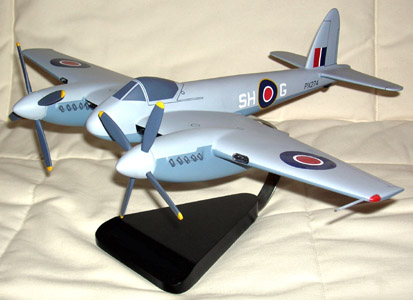 |
|
Model of PX274 commissioned by David Collins |
| Type | Unit | Base | Duty | Crew |
| Hornet F. Mk1 |
No. 64 Squadron |
RAF Linton-on-Ouse | Instrument Flying exercise |
1 |
De
Havilland Hornet Serial No. PX274 took off from No.
64 Squadron's base at RAF Linton-on-Ouse at approx 14:20 hours on
22nd December 1947 for a Local Instrument Flying exercise in cloud.
Some 50 minutes later the pilot is thought to have become uncertain of his
position and began to descend, unaware that he was over high ground. At 15:10
hours the aircraft exploded, as struck a hillside only some 100 yards from farm
buildings above Stacksteads near Bacup, Lancashire – Later, icing of the
windscreen was stated as a probable contributory factor in this accident. The
aircraft impacted on an area of sloping high ground at high speed and at a
relatively shallow angle causing total disintegration of the machine over a wide
area. The only parts of the aircraft to actually penetrate the surface of the
ground were the two engines, which even then were only partially buried, due to
the angle of impact and the nature of the ground, which has only a thin layer of
topsoil over loose stone and then bedrock at only three to four feet in depth
below the surface. The majority of the aircraft was reduced to small scraps,
which were spread over some two fields ahead of the impact point. The emergency
services were quickly on the scene and the area was sealed off, but personal
effects and scraps of uniform amongst the scattered fragments showed that the
pilot was beyond their help. The
pilot - Pilot II Ronald Feasby 634505 of No. 64 Squadron, aged 29, was killed
instantly in the crash and is buried at Eston Cemetery, Yorkshire, Section P.
grave 67
| Name | Position | Status |
| P.II. R. Feasby | Pilot | K. |
This site known to have been investigated by another group in the past, so our initial aim was merely to carry out a site survey to pinpoint the crash site and record it for our records. A metal detector grid search of the field ahead of the impact site produced numerous small aircraft fragments across a very wide area indicating a very high-energy impact at a shallow angle. The search area was then widened to the adjacent field, where the farmer indicated the actual impact had occurred and it was during this survey that we also came across some substantial readings from our deep-seeking equipment, in an area that the landowner assured us had not been touched by the previous group. This turned out to be right under a gateway and it transpired that this actually marked the impact point of the aircraft as the stone from the wall at this point had been so fragmented and the ground so left so unstable, that this section of wall could not be rebuilt and the gap had later been utilised as a gateway. After further discussion with the landowner we decided that in light of the rarity of the aircraft an excavation was warranted, even though the indicated amount of buried remains was limited. We then had to wait for a window when the field would be free of livestock and in the meantime we applied for the necessary MOD permit, which proved more difficult than most due to the extreme disintegration of the aircraft habing been noted in the official records.
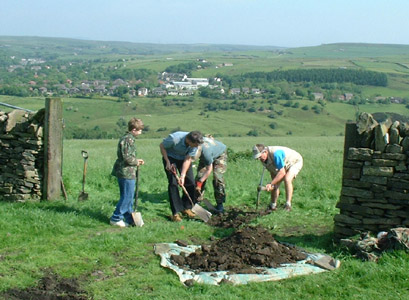 |
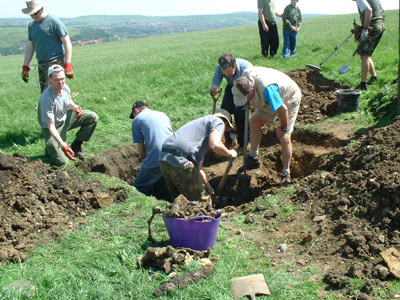 |
|
The dig gets underway - looking out across the valley in the direction from which the aircraft came in. |
Digging was hard going in the rubble strewn soil, but the limits of the disturbed ground were easy to discern. |
From the outset of this project, the excavation was planned to be a hand dig, as only relatively little wreckage was know to remain at the site and the detector readings and documentary evidence suggested that this was not likely to be deeply buried. Fortunately the appeal of excavating parts of such a rare aircraft meant that most of our members were willing volunteers and one a particularly fine weekend in June 2007 we began by removing rubble in-fill and the remains of the wall, which the aircraft had demolished, finding numerous small parts mixed in with the stone. Under this a small compacted mass of corrosion products contained a surprisingly intact oxygen bottle (considering the force of impact and the fact that it was mounted in the nose!), along with a reduction gear, piston and crushed liner, several engine valves, exhaust stubs, oil pump, parts of an engine bearer, crankcase bolts and numerous fragments of painted wood structure (much of it bearing a quite vivid blue paint finish) etc. A further small cache of parts, revealed during backfilling, included a small section of the canopy mounting rail, instrument parts and a couple of "covers" made from a bright blue coloured vinyl material. During the dig two of our members completed a grid search with metal detectors of the surrounding area locating the pitot head - embedded vertically about a foot down some 30 feet from the impact crater!
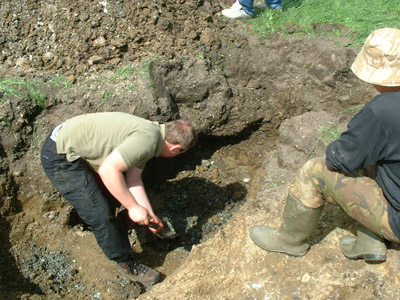 |
|
| Limit of the aircraft's penetration into the rocky ground is reached. | Smaller reduction gear from one of the Merlin engines. |
During our research the area excavated was identified as that depicted in a local newspaper report published at the time of the crash, illustrated with a photo showing recognisable parts of an engine lying in a shallow crater. It is believed some of these parts were removed at the time and the remainder were simply covered over with loose rubble and soil and are those we found. As this was obviously the impact crater caused by one of the engines, the oxygen bottle and piece of canopy rail were surprise finds, though the fact that the engines protruded forward of the cockpit could explain their presence, as they probably were forced in with the engine remains as the fuselage disintegrated. We also identified a small hollow nearby which did contain a few small fragments and we believed this was the crater caused by the other engine's impact and excavated by another group several years before..

|
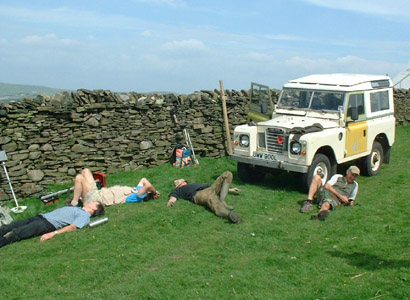
|
| The site reinstated following our excavation. | This lot clearly aren't used to digging by hand! |
Acknowledgements:
Alan Clark, Gareth Brown, John
& Wendy Bracewell, P. Meeks, David Collins.
This page & all articles on this site Copyright © Nick Wotherspoon 2010